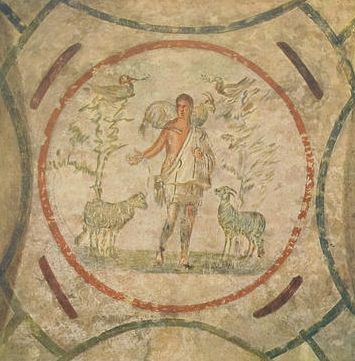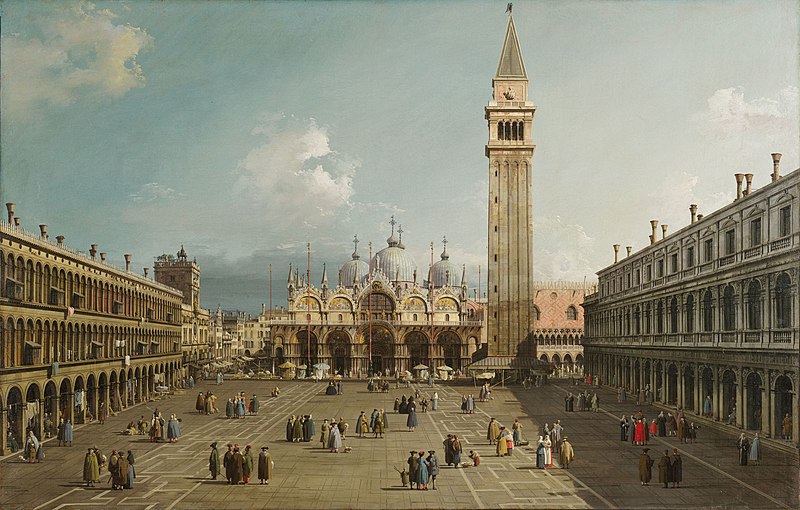Reflections on Venice and St. Mark's in particular
For several years I have actively wondered what the great Hagia Sophia looked like in its glory days as the greatest church of all Christianity. There are some books that reconstuct the liturgy. It is clear, for example, that there wasn't an opaque iconostasis, but there was something of a low wall and arched colonnade dividing the sanctuary from the nave. There was also a marked processional pathway between the sanctuary and the ambo, from which the scriptures were proclaimed in the middle of the assembly. There was also a bishop's throne against the back wall of the apse, and surrounded by terraced rows of seats for the presbyters. The ceremonial, involving processions, singing, prayers, various rites, etc., can be pieced together from contemporary documents. There were no seats for the assembly, except perhaps for the infirm and the elderly, which to my mind probably meant considerable mobility during the lengthy liturgies. Men and women were segregated -- men on the main floor and women inthe galleries, and there was a special gallery for the emperor and empress and their court.
The few surviving mosaics are tantalizing, but even they are not the early originals -- they date more or less from the 10th to the 14th centuries. After the fall of Constantinople to Mehmet II in 1453, the Turks immediately converted Hagia Sophia to a mosque, but actually preserved many of the mosaics by plastering over them rather than demolishing them. However, Hagia Sophia suffered terrible tragedies earlier in its history. The first was the iconoclastic dominance in the 7th and 8th centuries, which methodically and meticulously, as well as ruthlessly, destroyed all artwork representing Christ, Mary, and the saints, replacing them with simple crosses and geometric designs (as one sees in the apse of Hagia Irene. Nothing survived the ruthlessness of this movement. (Exceptions are in Milan, which I saw a few days ago, and Ravenna, where I am traveling to as I write this. In addition, there is a fragmentary 5th century mosaic of the annunciation in the Archaeological Museum of Istanbul, and a well preserved icon of the Virgin at St. Catherine's Monastery at Mt. Sinai, which I saw at the exhibit at the Getty a few years ago.) When Orthodoxy prevailed after the second council of Nicea, iconic art, including mosaics, again flourished. These are the examples we see today, at Hagia Sophia and many other places, but they are not the originals.
The next catastrophe was the fourth crusade, 1204, in which Catholic forces invaded and occupied Constantinople. They greedily and ruthlessly looted the treasures of the great churches, especially Hagia Sophia and the Twelve Apostles. The latter church, since the time of Justianian, had housed the tomb of Constantine, as well as tombs or relics of the apostles, and various objects that were held to be relics of the life and passion of Christ. These found there way to various shrines in Europe, and many to the treasury of St. Mark's in Venice, which I visited on Saturday.
The church second in importance to Hagia Sophia in Constantinople was the Twelve Apostles, which was leveled after the Turkish conquest in 1453 in order to build the Fatih Mosque. (Those who were on the first ECW Pilgrimage in 2006 may remember stopping there, mainly to view some foundation stones of the original building which some archeologists speculate were part of the original church. The importance I placed on this site puzzled many Pilgrims as well as Aydin our guide. Now, armed with a little more knowledge, I hope to revisit this site in 2010.)
Why this long and very generalized historical ramblings as prelude to reflecting on St. Mark's? First, in attending two Masses there yesterday, there were moments when I had the distinct feeling that I was in Hagia Sophia. Both the overall design and many archectural elements evoked the "feel" of Hagia Sophia. And the profusion of gold-background mosaics covering nearly every square inch (centimeter, I guess I should say) of the arches, domes, walls and bays, recall the splendor of what Hagia Sophia must have been like.
St. Mark's was originally built in the 800's, and was modeled after the Twelve Apostles, which has few surviving indications of what it looked like. Experts are quick to point out the western elements that were changed from the Byzantine style, but even when I mentally adjust for them, the Byzantine character of the building and its decoration comes through strikingly clear. I suspect the dimensions are similar to the Twelve Apostles, so one can get a good idea of the "feel" of that church as well.
A note on the domes. The Byzantine domes are definitely "flatter" than one seen at St Mark's, which are taller and almost "egg-shaped." They are certainly the precursors to the taller domes one sees on St. Peter's and many later western churches (as well as the US Capitol), and I wonder if they are also a strage in the development of the "onion-dome" that characterizes many central and easten European churches.
I was saddened to see the state of the treasury. The pitifully few remnants of the glory days of Constantinople looted from the Hagia Sophia are indifferently lumped together in dusty display cases, and the relics (often substantial pieces of bone in old reliquaries, but including several good sized pieces of the True Cross) are crowded on dusty glass shelves in a small room. (At least Louis IX built the magnificent Sainte-Chapelle in Paris to house the looted relics that came his way.) Everything is labeled in both Italian and English, which was helpful. I couldn't even try to sneak a few pictures because I left my camera in the hotel room because of the rain. There are photos of many of these things on the internet, and I hope to comment further. (IMHO Venice ought to "do the right thing" and return these relics and artifacts to the Orthodox Patriarch, like Pope John Paul II in 2004 returned the relics of St. John Chrysostom and St. Gregory Nazianzen, which were also part of the 1204 heist. They are beautifully displayed and venerated at the patriarchal church of St. George in Istanbul.)
Yesterday was beautiful, sunny and clear day. (Today it's cloudy again, and threatening rain. As the train was leaving Venice's Santa Lucia Station, I could see dark clouds and some lightning in the direction of St. Mark's.) I took the elevator to the top of the campanile (bell tower) in St. Mark's Square. The view was fantastic, and I could get a great view of the city in all directions -- evn the alps in the distance. Looking down at the roof confirmed my impression of the essential Byzantine character of the building itself. I think that spending some time talking about these things, with pictures, will help future Pilgrims understand some of the background of what they will see and experience on the Pilgrimage.
In the afternoon I also walked to the Rialto Bridge, and soaked in some of the "feel" for the city itself. And now I'm preparing for another "taste" of the early Byzantine world in the mosaics and churches/monuments of Ravenna.
These are some preliminary ramblings, written on the train to Ravenna. . . .
Now I've arrived in Ravenna, and checked into the Hotel Argentario. The city is so much more relaxed and spacious than Venice, which I began to find terribly oppressive. It's cloudy and off and on rainy, but fortunately I didn't get caught in it. The hotel, a short walk from the train station is roomy and accommodating, at 1/3 the cost of the one in Venice. Everything in this city -- at least the ancient stuff -- seems to be a relatively short walk. This afternoon and evening, though, I'm going to relax. There's a market and a department store a block or so from the hotel, and I may do a little shopping. I still need an umbrella.
 o, I had a nice "last meal" in a sort of rustic trattoria somehwere along the Viale Giulio Caesare, and came back to the hotel for a nap. Took a last walk around the area, and had a little dish of gelato, then came back to write this. Now it's time for bed. Got a long way to go tomorrow.
o, I had a nice "last meal" in a sort of rustic trattoria somehwere along the Viale Giulio Caesare, and came back to the hotel for a nap. Took a last walk around the area, and had a little dish of gelato, then came back to write this. Now it's time for bed. Got a long way to go tomorrow.





